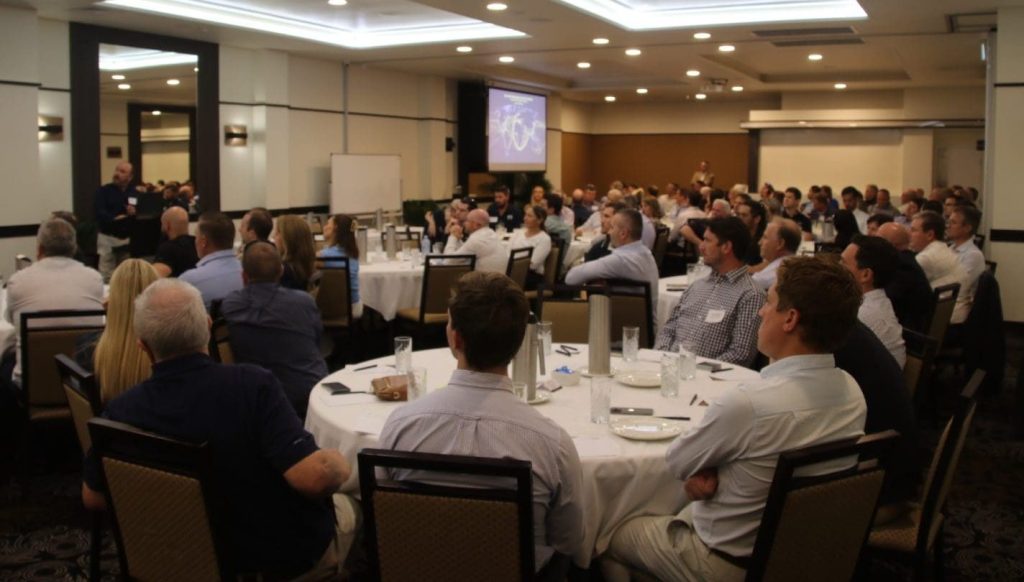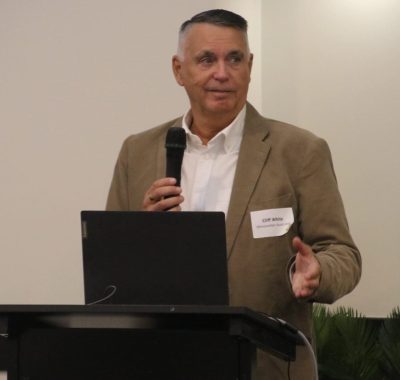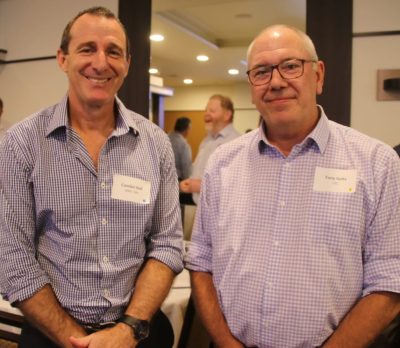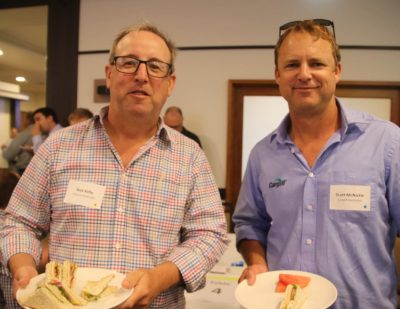
Cotton industry representatives gathered in Toowoomba last week to discuss post farm-gate topics.
MORE THAN 100 industry representatives gathered in Toowoomba last week for the Australian Cotton Shippers Association’s inaugural Post Farm-Gate Forum.
The event brought together logistics firms, shipping lines, merchants, ginners, and warehousing companies to collaborate and develop solutions to the cotton industry’s challenges in the year ahead.
It was also a part of ACSA’s strategy to foster industry collaboration, strengthen communication with the Australian Government, and enhance engagement with global trading partners.
The forum kicked off with presentations from ACSA chair Cliff White and industry representatives David Goss from MSC, AWH head of cotton and dry bulk Graeme Wood, ICM founder Matthew Leeson and Australian Cotton Ginners Association president Ben Suttor.

ACSA chair Cliff White.
Mr White said the size of the forum “exceeded a lot of our expectations”.
“Events like today give us the opportunity to come together to talk, network, recognise what’s going on, and it gives everyone the opportunity in a forum to contribute,” Mr White said.
Mr White said the size of the forum “exceeded a lot of our expectations”.
“Events like today give us the opportunity to come together to talk, network, recognise what’s going on and it gives everyone the opportunity in a forum to contribute.
“We are all competitors, but at the end of the day we are all involved in the cotton industry and it’s in everyone’s interest to promote a united front for cotton in a global marketplace.”

IMAC Queensland managing director Cambel Ball with LDC’s Tony Geitz.
He said the industry was hopeful of seeing an uplift in prices after seeing the market fall to “some of the lowest cotton prices that we’ve seen in years”.
After reaching highs of just under $1000 per bale in mid-2022, prices for the 2024 crop sit below the $600-per-bale level.
Mr White said this drop could be attributed to a leveling following the post-COVID volatility, economic factors, and strong global supply outweighing demand.
“Since [COVID]…there’s been inflation, interest rates, reduced demand, reduced consumer sentiment and that’s where we are today with those prices.
“However, as the saying goes: nothing kills low prices like low prices; I think we’re beginning to get the sense that perhaps we are somewhere around the low.”
He said uncertainty over future economic conditions was “clouded today” but “talking to a number of our customers there is a slightly better sense and sentiment for business and for prices”.
Mr White said there was also potential upside “in terms of the supply-and-demand balance”.
He said recently there had been “plenty of cotton around” but uncertainty around new crop from both the United States and Brazil could start to see a return to a more balanced supply-demand outlook.

ECOM Commodities Shay Dhareula, AgVantage Commodities Steve Dalton, Jaye Kurts from Seaway and ECOM Commodities Matt Thompson.
Volatility continues in global trade
A shift towards increased protectionism, ongoing conflict in the Red Sea, and China’s economic slowdown are expected to weigh on Australia’s cotton industry.
As a wholly exported commodity, cotton was heavily impacted by overseas conflicts, changes to trade flows, and availability of infrastructure, such as vessels and containers.
Discussing the global shipping outlook, MSC’s Mr Goss said there was potential for Australian cotton to benefit from the US tariff policy.
“[Donald Trump’s] applied some significant tariffs across the board and uniformly rather than…selectively tariffing,” Mr Goss said.
“China has been one of his main targets and Australia’s feeling the effect of that as are Canada and Mexico.”
He said Trump had imposed a 25-percent tariff on Chinese goods, with the Chinese government reacting by enacting a 15pc retaliatory tariff on the US.
“Some early indications are within the cotton industry itself is that there is some renewed interest from China for Australian cotton, so that hopefully generates an uptick in volumes sold to China throughout this year.”
Mr Goss said these movements could “start to reshape some of the trading patterns for the shipping industry”.
“Where there were some traditional relationships, traditional lanes the structure of those lanes will start to change.”
These potential shipping flow changes would come on top of the shift in operations required due to ongoing conflict in the Red Sea region.

Viterra Australia’s Nick Kelly with Scott McNickle from Cargill Australia.
Mr Goss said the conflict “has had a had a profound impact on the shipping industry” since the end of 2023.
“Shipping companies have had to deploy more vessels, carry more containers just to complete the journeys to regions from Australia.
“Unfortunately, with the prolonging of the Red Sea Crisis, that’s going to be a fact of life for us going forward into this year and potentially into next year.
“Patience in getting to markets, like Turkey, are going to be required.”
Chinese growth slows
Mr Goss said another factor influences global trade flows was the flow-on effects of the recent slowdown in Chinese economic growth, which was mostly led by the real estate sector.
He said this was “filtering down to the rank-and-file Chinese” and impacting the population’s spending capacity, which would “perhaps reduce some of the volumes that they consume”.
As a result, he said Chinese manufacturers were “spreading further and further inland to find those lower-cost manufacturing opportunities”.
“We’re seeing that spread cascade down into regional countries like Vietnam and like Malaysia.”
“Chinese interests are controlling businesses just to find lower cost base opportunities and that then changes the pattern of trade…because you will start to see products more largely into some of these second and third tier countries.”
Increased infrastructure investment
Mr Goss said another global trend which would filter down to the post farm-gate industry was a marked increase in shipping companies’ investment in infrastructure following a period of strong profits for the shipping industry post-COVID.
“Rather than sit on that money…shipping lines are by and large reinvesting that money into their assets and building more resilient and effective supply chains.”
He said this could be seen in more money being spent on building new ships and more containers as well as developing digital platforms to “create efficiencies within the industry”.
“Investment is also going into the hard infrastructure like ports, terminals, warehouses, road and rail assets to ensure that we have better networks and better capabilities to provide a more complete service.”
Grain Central: Get our free news straight to your inbox – Click here